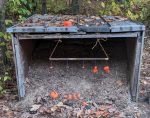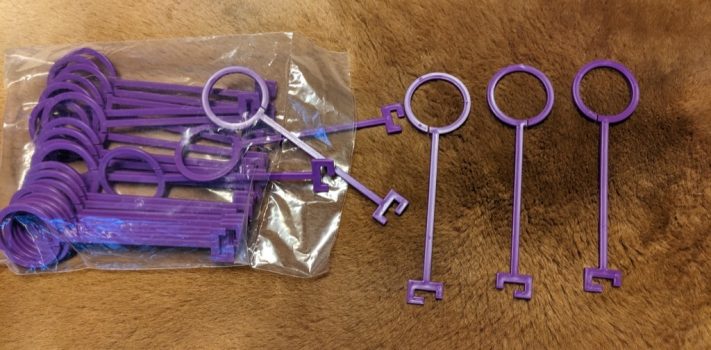“What are purple pigeon hooks? Are they used to hook purple pigeons? Where do purple pigeons live anyway? Why would someone want to hook them?”
Actually, purple pigeon hooks are not hooks designed to catch purple pigeons. They are hooks used to attach clay pigeons to a horizontal support. The hooks are molded from a purple-colored polymer. Attaching clay pigeons to a support transforms them into excellent stationary reactive targets.
I recently had the opportunity to test Yankee Thunder Purple Pigeon Hooks on the improvised range behind my pole barn. I was surprised by how much my accuracy began to improve already over the course of the very first range session. That is the opposite of what I typically experience when I am using non-reactive targets. With non-reactive targets, my accuracy usually tends to diminish somewhat over the course of a range session as carelessness and fatigue set in.
So Purple Pigeon Hooks are fun and helpful. You might want to give them a try. At the time of this writing, a package of 25 Purple Pigeon Hooks cost $19.99. You can receive an additional 10% off by using the promo code “survivalblog” when you order.
Background
Reactive targets have two major advantages over non-reactive targets. Reactive targets provide instant feedback, and they are more fun to shoot than non-reactive targets. Instant feedback makes range time more effective. More fun motivates shooters to spend more time at the range. More effective range time in greater quantity translates into increased accuracy.
I recently ran across Yankee Thunder Purple Pigeon Hooks online. They looked like an interesting way of transforming standard clay pigeons into reactive targets for handgun and rifle shooting. I asked Yankee Thunder for some samples for testing and evaluation. They were kind enough to send me a pack of 25 which soon arrived via USPS Ground Advantage from Layton, Utah.
Each hook is 5.5 inches long and is molded from a flexible, bright-purple polymer. There is a 1.5 inch diameter ring on one end of the hook with a cut in the ring to allow it to be slipped over a horizontal support like a pipe, tree branch, or wire. A clip on the other end of the hook snaps firmly onto the rim of a clay pigeon.
I was happy to note that Purple Pigeon Hooks are made in the USA.
Testing
 I went to the improvised range behind my pole barn. I ran a length of twine through a 3/4 inch pipe that is approximately 33 inches long. I then tied the ends of the length of twine to 2 eye screws attached to the top of my target backstop. The twine held the pipe horizontally about 1 foot above the ground.
I went to the improvised range behind my pole barn. I ran a length of twine through a 3/4 inch pipe that is approximately 33 inches long. I then tied the ends of the length of twine to 2 eye screws attached to the top of my target backstop. The twine held the pipe horizontally about 1 foot above the ground.
I then inserted a clay pigeon into each of 5 different purple pigeon hooks and slipped the ring of the hooks over the pipe.
Next, I loaded 16 rounds of Federal 36 grain copper plated hollow point .22LR into a Taurus TX22 that I was testing. From 15 yards away I then aimed off-hand at the left-most pigeon that was hanging from the pipe, and began shooting.
I found that even if the first couple of hits by a .22 caliber bullet did not shatter a clay pigeon, it was easy to see the dark holes in the pigeon created by the hits. Those holes contrasted well with the bright orange surface of the pigeon.
 My accuracy increased significantly over the course of the range session. Early on, it sometimes took a half dozen or so rounds to shatter just 1 pigeon. By the end of the session, I could shatter all 5 pigeons hanging from the pipe and still have rounds left in the magazine. And I could aim at smaller and smaller fragments of clay pigeon that were still hanging from a hook, and hit them successfully.
My accuracy increased significantly over the course of the range session. Early on, it sometimes took a half dozen or so rounds to shatter just 1 pigeon. By the end of the session, I could shatter all 5 pigeons hanging from the pipe and still have rounds left in the magazine. And I could aim at smaller and smaller fragments of clay pigeon that were still hanging from a hook, and hit them successfully.
I was having so much fun that I lost count of how many times I inserted new clay pigeons into the hooks after the old ones were shattered. I went into the barn several times to grab another stack of clay pigeons.
The hooks proved to be durable. I don’t think that they could survive a direct hit, but they were not at all damaged by near misses that shattered the clay pigeons that the hooks were holding. They also stood up well to new clay pigeons being clipped into place after the old ones were destroyed.
I finally decided that I had experienced a full quota of fun for the day. I picked up the largest broken pieces of clay pigeon, and put them in a waste bucket. I untied the pipe from the backstop, and put it away. I put the purple pigeon hooks back in the shipping envelope, and stored them next to my other range supplies. Then I went inside and cleaned the TX22.
Clay Pigeon History
Originally, live pigeons were used for shotgun target shooting competitions. Beginning in about 1875, these live pigeons began to be replaced by clay disks that were thrown by hand launchers or by spring loaded traps. These clay disks became known as “clay pigeons.”
Eventually, these disks began to be made of a mixture of pitch and pulverized limestone rather than of clay. So ironically, “clay pigeons” were never pigeon shaped and are no longer made of clay.
I remember the very first time that I came across a reference to clay pigeons. I was about 8 years old. I was reading one of the Childcraft anthology volumes that accompanied our family’s edition of the World Book Encyclopedia. The article that I was reading was the story of Annie Oakley’s first shooting competition against Frank Butler. I was fascinated by the fact that Oakley and Butler were shooting clay pigeons. I imagined them shooting intricately molded and decorated pottery birds. I did not feel that the aerodynamic qualities of a bird made out of clay would be very impressive. I imagined the spread wings of the ceramic pigeons tumbling through the sky after they were thrown. I wondered why Oakley and Butler didn’t shoot something less elaborate like glass balls or dinner plates.
About four years later, I completed my hunter safety class at school. This made me eligible to purchase a hunting license. I was eager to put this newly acquired privilege to good use. I talked my Dad into taking me pheasant hunting. In preparation for the hunt, he bought a couple of simple singe-shot shotguns (a 12 gauge for him and a .410 for me), some shells, a trap, and some clay pigeons. I finally found out that clay pigeons were not pottery birds at all.
We went out to my Uncle’s orchard, set up the trap, and Dad began teaching me to shoot. It took a bit more skill to break a clay pigeon with the .410 than it did with the 12 gauge, but the lighter recoil was appropriate for my smaller frame and the smaller .410 pattern was excellent training for effective wingshot performance.
Over the following decades, Dad and I had wonderful times hunting together for pheasant, duck, goose, deer, and other game. Sometimes my Mom joined us, which was somewhat unusual for women in that time and place. Most of my friends’ moms would never dream of going hunting. My Sisters would come along to shoot clay pigeons, but they never wanted to join a hunt. My younger Brother got dragged along on hunts, but did not really enjoy them. He would find a comfortable place to recline, lean his unloaded gun against a tree, and take a nap.
I would love the chance to sit in a blind again with my Dad and Uncle on a frosty morning, eating sour cream donuts, drinking hot chocolate, and listening to the honking of an approaching flock of geese. Those hunts were some of the best times of my life.
About Yankee Thunder
Yankee Thunder is a small, family-owned business that began in the owners’ garages in 2018. They initially produced target stands, and have subsequently expanded their product line to include steel targets, laser training aids, apparel, gun storage, and other “gear for men who love God, guns . . . and a good laugh.”
They now occupy a manufacturing facility that is not connected with their homes. They report that their wives are glad that they are no longer filling their garages with target stand parts and noxious paint fumes.
Conclusions
Yankee Thunder Purple Pigeon Hooks are a lot of fun. They are easy to use, durable, and American-made. I found them to be even more effective than I expected in enhancing my handgun accuracy. At $19.99 for a pack of 25, they represent a good value for the money.
One safety reminder: Clay pigeons and their fragments are toxic to domesticated pigs and feral hogs.
Disclaimer
Yankee Thunder was kind enough to provide me with a package of 25 Purple Pigeon Hooks for testing and evaluation. Taurus was kind enough to loan me a sample of their TX22 handgun for testing and evaluation. I tried not to let the kindness of either of these two vendors interfere with the objectivity of my review, and I believe that I have succeeded. I did not receive any other financial or other inducement to mention any vendor, product, or service in this article.










